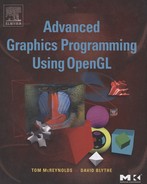Table of Contents
The Morgan Kaufmann Series in Computer Graphics and Geometric Modeling
Chapter 1: Geometry Representation and Modeling
1.2 Decomposition and Tessellation
1.5 Vertices and Vertex Arrays
1.6 Modeling vs. Rendering Revisited
2.2 Overview of the Transformation Pipeline
2.4 Texture Coordinate Generation and Transformation
2.6 Visualizing Transform Sequences
2.8 The Z Coordinate and Perspective Projection
Chapter 3: Color, Shading, and Lighting
3.4 Fixed-Point and Floating-Point Arithmetic
Chapter 4: Digital Images and Image Manipulation
5.3 Loading Texture Images from the Frame Buffer
5.7 Additional Control of Texture Level of Detail
Chapter 6: Rasterization and Fragment Processing
Chapter 7: Window System and Platform Integration
7.6 Direct and Indirect Rendering
Chapter 8: OpenGL Implementations
8.3 OpenGL ES for Embedded Systems
8.5 Hardware Implementations of the Pipeline
Chapter 9: Multiple Rendering Passes
10.4 Line and Point Antialiasing
10.5 Antialiasing with Textures
Chapter 11: Compositing, Blending, and Transparency
11.2 Other Compositing Operators
11.5 Compositing Images with Depth
11.6 Other Blending Operations
11.9 Alpha-Blended Transparency
11.10 Screen-Door Transparency
Chapter 12: Image Processing Techniques
12.8 Image-Based Depth of Field
12.9 High-Dynamic Range Imaging
Chapter 13: Basic Transform Techniques
13.1 Computing Inverse Transforms Efficiently
13.6 Texture Coordinate vs. Geometric Transformations
13.7 Interpolating Vertex Components through a Perspective Transformation
Chapter 14: Texture Mapping Techniques
14.1 Loading Texture Images into a Framebuffer
14.2 Optimizing Texture Coordinate Assignment
14.8 Dual-Paraboloid Environment Mapping
14.10 Texture Color Coding and Contouring
Chapter 15: Lighting Techniques
15.1 Limitations in Vertex Lighting
15.2 Fragment Lighting Using Texture Mapping
15.3 Spotlight Effects Using Projective Textures
15.4 Specular Lighting Using Environment Maps
15.8 Per-fragment Lighting Computations
15.10 Bump Mapping with Textures
15.13 High Dynamic Range Lighting
Chapter 16: CAD and Modeling Techniques
16.4 Geometric Level of Detail
16.5 Visualizing Surface Orientation
16.6 Visualizing Surface Curvature
16.7 Line Rendering Techniques
16.8 Coplanar Polygons and Decaling
16.10 Constructive Solid Geometry
17.3 Creating Environment Maps
18.3 Procedural Texture Generation
Chapter 19: Illustration and Artistic Techniques
19.1 Projections for Illustration
19.2 Nonphotorealistic Lighting Models
Chapter 20: Scientific Visualization
20.1 Mapping Numbers to Pictures
20.2 Visual Cues and Perception
20.5 Scalar Field Visualization
20.6 Vector Field Visualization
20.7 Tensor Field Visualization
Chapter 21: Structuring Applications for Performance
21.1 Structuring Graphics Processing
